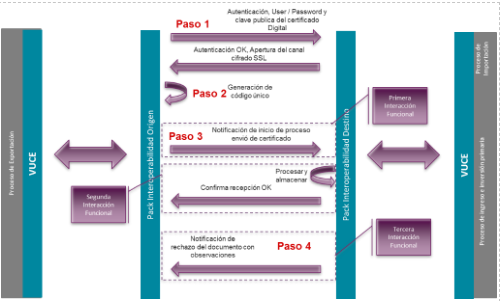A. General Information
Interoperability of the Foreign Trade Single Windows in the Pacific Alliance
B. Lessons Learned
The Pacific Alliance interoperability project aims at connecting single windows of its four member states in line with international standards. It first focused phytosanitary certificate data and COO data and allowed for cost reduction for operators, reduced corruption and trade facilitation.
Streamline and facilitate foreign trade operations, through the implementation and promotion of its “Single Windows of Foreign Trade" (VUCEs by its initials in Spanish), ensuring interoperability that allows the electronic exchange of information of foreign trade transactions, for example: international phytosanitary certificates, certificates of origin, customs declarations, etc., in line with accepted international standards.
In 2011, the construction of the Pacific Alliance began with the objective of move towards the free circulation of goods, services, capital and people between the member countries of the Pacific Alliance (Colombia, Chile, Mexico and Peru), as well as being a platform for economic and commercial integration, and for projection to the world with special emphasis on the Asia Pacific region.
Lead the interoperability of the Trade Single Windows and paperless commerce, connected in real time to operators and agents of commerce.
System that facilitates the integration between "Single Windows of Foreign Trade" of each country.
Support the public and private sectors to facilitate cross-border trade.
Exchange of phytosanitary and origin certificates
Information protected and guarded by each of the countries (governance in interoperability)
Automatic notifications to the countries involved, in case of intermittency or failure of transactions.
Management and monitoring of transactions, incoming, outgoing and incomplete
Procedures established in case of contingency.
Communication diagram

Phytosanitary certificate
Certificate of origin
To agree among the business, regulatory and technical teams, of all countries, the data to be exchanged; ensuring the same understanding and complying with international standards.
Schedule follow-up meetings, without interfering with the usual activities of each of the work teams.
Agree on dates of implementation, testing and release, of each of the documents to be exchanged.
Rotation in the members of the work teams, delayed the dates of compliance in the work plan established
The use of an electronic signature to obtain official documents that are transmitted electronically is not common in all countries, so exporters still have little reliability in these; which has forced countries to receive documents electronically and on paper, forcing them to preserve mechanisms that could be eliminated.
Priorities of the agencies change and become an stoppers or decrease the potential of the implementation.
Exporter:
Reduction of the time to obtain the authorization that will allow him to export / import the goods, because the authorization is received electronically.
Knows at all time, the status of the document sent to the authorized entity, in the country of destination: sent, received correctly, incorrectly received, used, request for replacement, etc., helping with this, to the subsequent activities that the exporter can carry out.
Increases his competitiveness
Agency:
Automatic sending and receiving of electronic documents, facilitating verification operations in the countries involved.
Receives email notifications about the electronics documents that for some reason didn’t complete its transmission, which allows to execute protocols that guarantee reception in the destination country.
The Inter-American Development Bank (BID in Spanish acronyms) has been the promoter and sponsor of the interconnection project of the foreign trade single windows (VUCE) of the member countries of the Pacific Alliance, to allow the regional exchange of data and reliable and effective electronic information in real time; taking into account the recommendations, good practices and international standards, as well as those related to regulations, harmonization of data and technology.
The next document to interoperate is the "Customs Declaration".
It is planned to expand the exchange "territorially", because in the Declaration of Puerto Vallarta, Mexico, on July 24, 2018, the member countries of the Pacific Alliance welcomed as associated states: Australia, Canada, New Zealand and Singapore.
C. Relevant Standards
Only authorized government officials can electronically sign electronic documents
Authorized government officials must have a digital certificate (which complies with the X509 standard) issued by trusted CA.
The digital certificate used by the government official is current and not revoked.
There is a repository where the keys of the government officials who sign the electronic documents and who have been authorized by the member countries of the project are stored.Digital signatures are based on the Digital Signature XML standard: XMLDSIG <xs: element ref = "ds: Signature" /> and are of type "Envelope signature"

